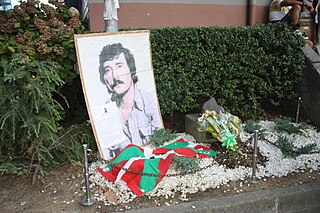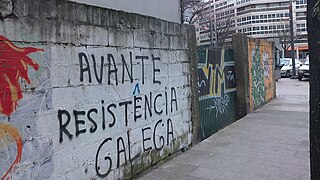
The Ertzaintza, is the autonomous police force for the Basque Country, largely replacing the Spanish Policía Nacional and Guardia Civil. An Ertzaintza member is called an ertzaina.

GAL were death squads illegally established by officials of the Spanish government to fight against ETA, the principal Basque separatist militant group. They were active from 1983 until 1987, under the Spanish Socialist Workers Party (PSOE)-led governments. At trial, it was proven that they were financed by important officials within the Spanish Ministry of the Interior. The Spanish daily newspaper El Mundo played an important role in revealing the plot when it ran a comprehensive series of articles on the matter.

Getxo is a town located in the province of Biscay, in the autonomous community of the Basque Country, in Spain. It is part of Greater Bilbao, and has 77,946 inhabitants (2019). Getxo is mostly an affluent residential area, as well as being the third largest municipality of Biscay.

The 2006 Madrid–Barajas Airport bombing occurred on 30 December 2006 when a van bomb exploded in the Terminal 4 parking area at the Madrid–Barajas Airport in Spain, killing two and injuring 52. On 9 January 2007, the Basque nationalist and separatist organisation ETA claimed responsibility for the attack. The attack, one of the most powerful carried out by ETA, damaged the airport terminal and destroyed the entire parking structure. The bombing ended a nine-month ceasefire declared by the armed organisation and prompted the government to halt plans for negotiations with the organisation. Despite the attack, ETA claimed that the ceasefire was still in place and regretted the death of civilians. The organisation eventually announced the end of the ceasefire in June 2007.

José Antonio Urrutikoetxea Bengoetxea, also known as Josu Urrutikoetxea and Josu Urrutikoetxea Bengoetxea, is a former member of the Basque separatist organization ETA. In separate trials over a number of years, he was convicted for his involvement in the 1986 Plaza República Dominicana bombing and the 1987 Zaragoza barracks bombing, which together killed 23 people, including five children.
ETA's 2006 "permanent ceasefire" was the period spanning between 24 March and 30 December 2006 during which, following an ETA communiqué, the Spanish government, led by José Luis Rodríguez Zapatero on one side, and the militant group on the other, engaged in talks as a means to agree on a formula to voluntarily disband the latter. It was terminated as a result of the 2006 Madrid Barajas International Airport bombing.
Miguel Garikoitz Aspiazu Rubina alias Txeroki ("Cherokee") is an ETA member. He headed the military/commando unit of the group until his arrest in France on 16 November 2008.
Jurdan Martitegi Lizaso is a member of the armed Basque nationalist and terrorist group Euskadi Ta Askatasuna (ETA). He is best known as the head of the military/commando unit of the group since late 2008 until April 18, 2009, when he was arrested by French police. He is considered to be one of the most dangerous members of ETA, considered a terrorist organization by the European Union, with police describing him as "extremely violent".
The 2009 Palma Nova bombing occurred on July 30, 2009, when a limpet bomb went off outside a Civil Guard barracks in the town of Palma Nova, Majorca, Spain. The bomb was placed under a patrol car and two Civil Guard officers died as a result of the explosion. A second device was found under another Civil Guard vehicle at nearby barracks and safely exploded by police. On August 9, the Basque nationalist and separatist organisation ETA claimed responsibility for the attack, while four other bombs exploded around restaurants and shopping centres in Palma, Majorca, causing no injuries.
The Vic bombing was an attack carried out by the Basque separatist group ETA which occurred on 29 May 1991 when a car bomb carrying more than 200 kg of explosive was detonated inside the courtyard of a Civil Guard barracks in the Catalan city of Vic, Spain. The bombing killed 10 people, including five children, and injured 44 people.

Resistência Galega, sometimes referred to as REGA, is the term used by a series of left-wing and Galician separatist organisations and individuals to claim attacks in Galicia. The term was first used in 2005 when a manifesto named Manifesto da Resistência Galega appeared on the Internet. Since then, Resistência Galega has carried out dozens of attacks against political party offices and banks across Galicia.

The 2008 Getxo bombing occurred on 19 May 2008, when a van bomb went off outside a boat club in the town of Getxo, Biscay in the Basque Country, Spain. The attack caused serious damage to the club, as well as nearby buildings and structures. No one was killed or injured after a warning call from the Basque separatist organisation ETA. On 31 May, the organisation claimed responsibility for the bombing.

The Zaragoza barracks bombing was a car bomb attack by the Basque separatist organisation ETA, which occurred on 11 December 1987. A vehicle containing 250 kilograms (550 lb) of ammonal was parked beside the main Guardia Civil barracks in the city of Zaragoza, Aragon, Spain; its subsequent explosion killed 11 people, including 5 children. Another 88 people were injured, the majority of them civilians.
The Plaza República Dominicana bombing was a car bomb attack carried out by the armed Basque separatist group ETA in Madrid, Spain on 14 July 1986, which killed 12 people and injured another 32. The dead were all members of the Guardia Civil studying in the nearby traffic school on Príncipe de Vergara. The ETA members later convicted of participation in the attack included significant figures in the group, including Antonio Troitiño and Iñaki de Juana Chaos.
The 1980 Markina attack was a mass shooting gun attack by the Basque separatist organisation ETA which occurred on 20 September 1980 near the Basque town of Markina. The targets were a group of off-duty civil guards who were having lunch in a bar in the town. Four civil guards were killed. The attack was one of the deadliest of 1980, the year when ETA killed more people than any other.
The Madrid bombings were car bomb attacks carried out by the armed Basque separatist group ETA in Madrid, Spain on 21 June 1993, which killed 7 people and injured a further 29. The target was an army vehicle transporting members of the army. The dead included four Lieutenant colonels, a Commander, a Sergeant and the civilian driver of the vehicle. This was ETA's deadliest attack of 1993.

The Sabadell bombing was a car bombing carried out by the armed Basque separatist group ETA in Sabadell, Catalonia, Spain on 8 December 1990.

The Monbar Hotel attack was carried out by the Grupos Antiterroristas de Liberación (GAL), a Spanish state-sponsored death squad, on 25 September 1985 in Bayonne, Pyrénées-Atlantiques, France. The targets were four members of the Basque separatist terrorist group Euskadi Ta Askatasuna (ETA), whom the Spanish government believed to be senior figures in the organization, itself proscribed as a terrorist group in Spain and France. All four people were killed, with a fifth person, apparently unconnected to ETA, injured in the shooting. This represented the deadliest attack carried out by the GAL. Although two of the participants were apprehended shortly after the shooting, controversy surrounded the possible involvement of senior figures in the Spanish police.
Terrorism in Spain has been committed by various groups and people.











